| 1947 |
 Chronomedia index Chronomedia index
Numbers after entries link to the list of references. |
links and notes |
| |
Cultural highlights | Predictions made this year |
|
| January 1 |
DuMont television station WTTG TV begins transmissions on channel 5 in Washington DC. |
|
| January 3 |
Opening session of US Congress is televised for the first time to viewers in Washington, Philadelphia and New York. |
|
| January 22 |
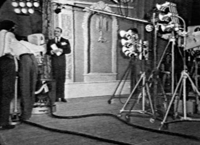 Hollywood-based KTLA-TV goes on air on Channel 5 in Los Angeles, the first television station west of the Mississippi. It broadcasts a 30-minute variety show from the Paramount TV theatre starring Bob Hope (in picture, right), Dorothy Lamour, William Bendix and Jerry Colonna. It is estimated that 322 television receivers are in use in Los Angeles. Hollywood-based KTLA-TV goes on air on Channel 5 in Los Angeles, the first television station west of the Mississippi. It broadcasts a 30-minute variety show from the Paramount TV theatre starring Bob Hope (in picture, right), Dorothy Lamour, William Bendix and Jerry Colonna. It is estimated that 322 television receivers are in use in Los Angeles. |
> 1951 |
| January |
CBS broadcasts partially mechanical colour television signals from the Chrysler Building in New York. Two days later RCA broadcasts in colour from Penn’s Neck Community Club, Princeton, NJ. |
|
| January 30 |
Federal Communications Commission (FCC) says a decision about a colour television system would be premature. The CBS system would require further testing before approval. |
|
| February 1 |
UK government nationalises Cable & Wireless. |
|
| February 8 |
NBC affiliate television station KSD TV (later KSDK) begins transmissions on channel 5 in St Louis, Missouri. |
|
| February 17 |
Voice of America radio broadcasts to the USSR begin. |
|
| February 21 |
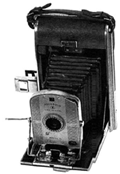 In New York Edwin H Land demonstrates the Polaroid Land camera, which can produce a monochrome photograph in one minute, to the Optical Society of America. In New York Edwin H Land demonstrates the Polaroid Land camera, which can produce a monochrome photograph in one minute, to the Optical Society of America. |
|
| March 4 |
NBC affiliate station WWJ TV (now WDIV) goes on air on channel 4 in Detroit, Michigan. |
|
| March |
Ronald Reagan is elected president of the Screen Actors Guild (SAG). |
|
| • |
First BBC attempts to record television programmes from the face of the screen using a film camera. Great problems are caused by trying to record 25-frame television images using a 24 fps 35mm camera. A compromise is to record 50 per cent of the television picture (ie, alternate fields), using the other 50 per cent of the time to pull down the film. |
|
| March 24 |
Federal Communications Commission rejects CBS’s application to shift broadcasting into the UHF band, ending industry and consumer confusion and hesitation. |
|
| April |
In Australia, Greater Union ends film production at Cinesound Studios and a co-production venture with UK’s Ealing Studios is aborted when the UK government announces imposition of a 75 per cent tax on all film imports. |
|
| April |
RCA demonstrates its latest version of projection television at the National Association of Broadcasters (NAB) Convention in Atlantic City, New Jersey. |
Cinema-television |
| May 8 |
House Un-America Activities Committee (HUAC), chaired by J Parnell Thomas, convenes in Hollywood to investigate communism in the film industry. |
The 'red menace' in Hollywood |
| June 5 |
First live French television programme originated from outside the studios comes from the Théâtre des Champs-Élysées in the avenue Montaigne. |
|
| June 27 |
NBC television station WRC TV goes on air on channel 4 in Washington, DC. |
|
| June |
Television service starts in Canada. |
Television service start dates |
| June |
Since the FCC decision in favour of VHF television broadcasting in April, 60 applications have been made to launch television stations. |
|
| July 3 |
Elia Kazan and Cheryl Crawford found the Actors’ Studio in New York to develop the ‘method acting’ techniques pioneered by Stanislavsky. |
|
| July |
RCA signs an agreement with Twentieth Century-Fox and Warner Bros for research and development of a direct-projection large-screen cinema television system. |
Cinema-television |
| July |
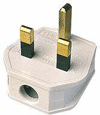 British Standard BS1363 establishes the 13 amp three-pin plug, replacing seven different round-pin plugs. Under development since 1943 in anticipation of a post-war copper shortage, it standardises UK electrical installations and permits the development of ring-main architecture that is economical in its use of copper wiring. British Standard BS1363 establishes the 13 amp three-pin plug, replacing seven different round-pin plugs. Under development since 1943 in anticipation of a post-war copper shortage, it standardises UK electrical installations and permits the development of ring-main architecture that is economical in its use of copper wiring. |
|
| August 6 |
UK Treasury imposes 75 per cent customs duty on the value of imported films under the Import Duties Act 1932 with immediate effect. The tax is payable in advance on the basis of anticipated box office earnings. |

W Glenvil Hall statement as Chief Secretary to the Treasury |
| August 9 |
Motion Picture Association of America (MPAA) suspends all shipments of films to the UK. However, there are already around 125 American films awaiting release in the UK, although US imports currently account for 80 per cent of screen time. |
US film boycotts |
| August 24 |
First Edinburgh Festival opens at the Usher Hall. |
|
| September 13 |
ABC television station WPVI TV begins transmissions on channel 6 in Philadelphia, Pennsylvania. |
|
| September |
International Federation of Film Societies formed in Cannes, France. |
|
| September |
Of the 47,000 television sets in use in New York City, 3,000 are in bars, the rest in high-income households. The total number of television sets now in use in the US is put at 60,000. |
|
| October 3 |
WMAL TV (later WJLA) begins transmissions on channel 7 in Washington, DC. |
|
| October 5 (or 9) |
In the first White House address to be shown on television President Truman appeals for a voluntary ban on eating meat on Tuesdays and poultry on Thursdays to allow grain to be saved to relieve food shortages in Europe. |
|
| October 9 |
First telephone conversation between an aeroplane and a car telephone is made in and above Wilmington, Delaware. |
|
| October 20 |
In Washington DC, the House Un-American Activities Committee (HUAC) re-convenes its hearings about communism in Hollywood. Charles Chaplin, Katherine Hepburn and Edward G Robinson are among actors denounced as left-wing sympathisers. |
> November 24 |
| October 27 |
NBC television station WMAR TV goes on air on channel 2 in Baltimore, Maryland. |
|
| October |
Britain's film quota regulations, suspended during the war, are re-instated with the screen time reserved for British feature films set at 25 per cent. |
Quotas and levies |
| November 9 |
First high-definition telerecording is made by BBC Television to produce a re-transmission of the Remembrance Service outside broadcast from the Cenotaph, which is shown live in the morning for the first time. The film is re-broadcast in the US by NBC the same evening.
Within the television service, telerecording is perceived to be a way of saving on limited resources by allowing repeats to be broadcast, but this does not become regular practice for at least another eight years. |
|
| November 12 |
Radio station KPO in San Francisco, California becomes KNBR (later KNBC). |
|
| November 20 |
BBC Television stages a major outside broadcast production of the marriage of Princess Elizabeth and Prince Philip Mountbatten. The event is telerecorded. |
|
| November 24 |
Maurice Gorham resigns as Controller of the BBC Television Service out of frustration that management of television is made one of six divisions of the BBC Home Service rather than being given the degree of independence he believes it needs. He is replaced by Norman Collins. [0044] |
|
| November 24 |
In Washington DC, the House Un-American Activities Committee (HUAC) declares a list of 'unfriendly witnesses', who become known as the Hollywood Ten, who had refused to answer questions about communist influence in the film industry and are jailed for contempt of Congress. |
The 'red menace' in Hollywood |
| November 25 |
Movie studio executives agree to blacklist the Hollywood Ten. |
|
| December 10 |
Paramount Pictures gives a demonstration of large-screen television using 35mm film recordings made off-air. |
Cinema-television |
| • |
As well as effectively owning the DuMont television network, Paramount has stakes in four on the top nine US television stations and has interests in a number of basic television patents. |
|
| December 16 |
Bell Laboratories patents the point-contact transistor (trans-resistance device). |
|
| December 17 |
ABC affiliate station WEWS TV goes on air on channel 5 in Cleveland, Ohio. |
|
| December 23 |
John Bardeen and Walter Brattain of AT&T Bell Labs in Murray Hill, New Jersey, announce development of the transistor. William Schockley subsequently improves the design as a junction transistor. |
|
| December |
In Milwaukee, Wisconsin, NBC-affiliated television station WTMJ TV begins transmissions on channel 4. |
|
| December |
After achieving storage of 2,048 bits on a cathode ray tube (to become known as a Williams tube), Tom Kilburn at Manchester University, who wrote the first program for it, writes a progress report on A Storage System for Use with Digital Computing Machines. The ideas are picked up in the USA and USSR and the British government funds the university to build a commercial machine. |
|
| • |
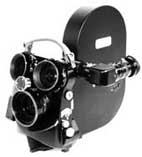 French camera manufacturer Eclair introduces the Caméflex camera, with a clip-on magazine for pre-loaded film incorporating the loops, a rotatable eyepiece, a rotating turret with divergent lenses, a 200-degree opening in the reflex mirror shutter. With the eyepiece near the front of the camera and the magazine at the rear, the camera can sit on the operator's shoulder, only the second camera to feature this design. French camera manufacturer Eclair introduces the Caméflex camera, with a clip-on magazine for pre-loaded film incorporating the loops, a rotatable eyepiece, a rotating turret with divergent lenses, a 200-degree opening in the reflex mirror shutter. With the eyepiece near the front of the camera and the magazine at the rear, the camera can sit on the operator's shoulder, only the second camera to feature this design. |
|
| • |
3M produces its first audio tape, Scotch Brand 100, for use with AEG Magnetophone machines. This is a paper-backed tape coated with iron particles. It is followed by Scotch Brand 110, a black oxide plastic-based tape. |
|
| • |
John Mullin demonstrates a modified Magnetophone tape recorder to Bing Crosby Enterprises. Alexander M Poniatoff, head of the US firm Ampex, witnesses the demonstration; Ampex is given an order to produce 20 self-designed recorders for Bing Crosby Enterprises. |
|
| • |
Seventeen US firms are manufacturing wire and tape recorders. |
|
| • |
British Lion Group is sold to rival film producer Alexander Korda’s London Films. Among assets are Shepperton Studios, Worton Hall Studios at Isleworth and Beaconsfield Studios. The latter remains leased to the Ministry of Works, which now spends £146,000 refurbishing it as a production base for the Crown Film Unit. |
|
| • |
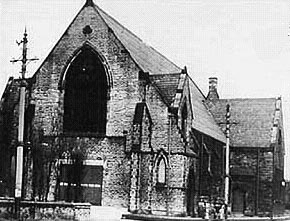 Producer John E Blakely converts a former Wesleyan Methodist chapel in Dickenson Road, Rusholme, Manchester [right] into a two-stage studio to produce comedy and musical films starring north of England artistes, including the very popular Frank Randall. Producer John E Blakely converts a former Wesleyan Methodist chapel in Dickenson Road, Rusholme, Manchester [right] into a two-stage studio to produce comedy and musical films starring north of England artistes, including the very popular Frank Randall. |
|
| • |
Rank Organisation makes Bell & Howell 16mm sound projectors in UK under licence. |
|
| • |
Rank Organisation sells Amalgamated Studios at Elstree, not yet used for production (see 1939) to the Prudential Assurance Company, which had lost heavily from its investments to Alexander Korda in the pre-war years. The Prudential sells the studios on to MGM, which names them the MGM British Studios.
Rank Organisation acquires the MP Studios at Elstree, now renamed Gate Studios, for use by GHW Productions and the production of religious films. |
|
| • |
Domestic audio tape recorder, the Soundmirror, is introduced by Brush Development Company of Cleveland, Ohio. Half-hour tapes cost $2.50. |
|
| • |
Federal Communications Commission makes the 460-470 MHz UHF radio frequencies available to licensees among the general public, opening the way to Citizens Band radio. The first licence is issued to Phineas Thaddeus Veeblefetzer, the 'handle' of Al Gross, pioneer of mobile radio communications, who had been lobbying for allocation of a personal radio communications spectrum. |
> 1958 |
| • |
US manufacturers turn out 175,000 television receivers during the year. The average price of a set is $279. |
|
| • |
During the year 152 advertisers buy time on US television. |
|
| • |
Hungarian-born Dennis Gabor (1900-1979), research engineer at British Thompson-Houston subsidiary Rugby Electrical Company in Scotland, describes the principles of holography but lacks a strong enough coherent light source and sufficiently high quality photographic emulsion. |
> 1971 |
| • |
First Czechoslovakian colour film: Jan Rohác of Duba, directed by Vladimir Borský. |
|
| • |
General Overseas Service of the BBC is started. |
|
| • |
BBC relay of La Bohème from Cambridge Theatre, London is the first televised full-length opera. |
> 1951 |
| • |
Chester Carlson begins collaboration with Haloid photographic company to develop the commercial potential of xerography, his photocopying system. |
> 1959 |
| • |
US audio record sales jump 45 per cent to 400m discs. Sales of radio-phonographs climb to 3.415m. |
|
| • |
Magnum photographic agency is founded by Robert Capa, Henri Cartier-Bresson, George Rodger and David Seymour. |
|
| • |
Influenced by Ernest Tubb, who headlines the first country music concert at Carnegie Hall, New York, trade magazine Billboard agrees to use the term 'country and western' instead of 'hillbilly'. |
|
| • |
 Clavioline, an electronic keyboard instrument, is invented by Constant Martin. It is used to create music for the BBC radio series Journey Into Space (1953-1958) and on such hit records as Del Shannon's Runaway (1961), Joe Meek's production of Telstar by the Tornados (1962) and the Beatles' Baby, You're a Rich Man (1967). Clavioline, an electronic keyboard instrument, is invented by Constant Martin. It is used to create music for the BBC radio series Journey Into Space (1953-1958) and on such hit records as Del Shannon's Runaway (1961), Joe Meek's production of Telstar by the Tornados (1962) and the Beatles' Baby, You're a Rich Man (1967). |
|
| • |
With wartime restrictions on circulation relaxed, Daily Mirror becomes the second largest selling UK newspaper (3.702m) after Daily Express (3.855m). |
|



















